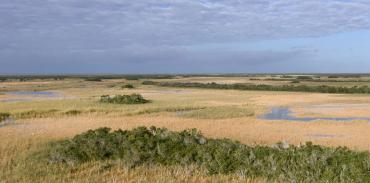
There's nothing technically "iffy" about the South Florida Water Management District's favored plan for the Southern storage reservoir called for last year in Senate Bill 10. It's "technically sound and based on a foundation of successful scientific practices and engineering," according to an independent external peer review released this week.
The SFWMD Tentatively Selected Plan (TSP) plan for the Everglades Agricultural Area (EAA) Storage Reservoir -- would reduce damaging discharges to the northern estuaries, deliver clean water for Everglades restoration and meet water quality standards, according to the independent firm Battelle Memorial Institute.
"This plan combines sound science with public feedback to achieve all of the goals and objectives of state law," said SFWMD Governing Board Chairman Dan O'Keefe. "After all the hard work our staff put into designing this reservoir project in such a short time, it is rewarding to see an independent expert review validate the District's scientific process and conclusions."
The District contracted Battelle Memorial Institute to review SFWMD's findings in the Post Authorization Change Report (PACR) for the Central Everglades Planning Project (CEPP) that seeks federal approval and cost-sharing to build the EAA Storage Reservoir. Battelle is the same firm that in 2012 performed the required independent review of the original CEPP plan approved by Congress.
"Based on the panel's review, the SFWMD CEPP PACR is a well-written document that provides excellent supporting documentation on economic, engineering, environmental and plan formulation issues and decisions," the independent review states. "The report provided a balanced assessment of the economic, engineering and environmental issues of the overall project."
The Institute's review also determined that the engineering documents that will be used for federal review of the project were "well written and thorough given the breadth of the analysis performed to support the document."
Together with authorized projects, the TSP would send an annual average of approximately 370,000 additional acre-feet of clean water south to the Everglades that will be protected by rule or reservation to benefit the natural system, the District claims in a press statement. The TSP would also reduce the number of damaging discharge events from Lake Okeechobee to the northern estuaries by 63 percent when used in conjunction with authorized projects.
The additional flows south to the Everglades proposed by the TSP would be treated in a new 6,500-acre Stormwater Treatment Area (STA) in combination with existing STAs and Flow Equalization Basins (FEBs), such as the A-1 FEB, to meet state water quality standards.
The reservoir would store 240,000 acre-feet of water on the 10,100-acre site comprised of the District-owned A-2 parcel and lands to the west as identified in SB 10. The TSP would work in conjunction with Gov. Rick Scott's Restoration Strategies for a total of 350,000 acre-feet of above-ground storage south of Lake Okeechobee.
SFWMD has kept the public informed on the Everglades Agricultural Area Storage Reservoir every step of the way through its innovative web page that features an interactive map and milestone tracker.
The net increase in cost over the currently authorized CEPP is $1.1 billion. The total cost, defined as the capital investment costs, of the authorized CEPP, as modified by the PACR TSP, is $3.14 billion (2018 price level), SFWMD reports.
The PACR was approved by the SFWMD Governing Board on March 8 and, along with the independent review, will be sent to the assistant secretary of the Army, Civil Works for federal approval and cost sharing by March 30.
For modeling data and more information on the previously held meetings, including agendas and presentations, the District directs you to www.sfwmd.gov/eaareservoir.


